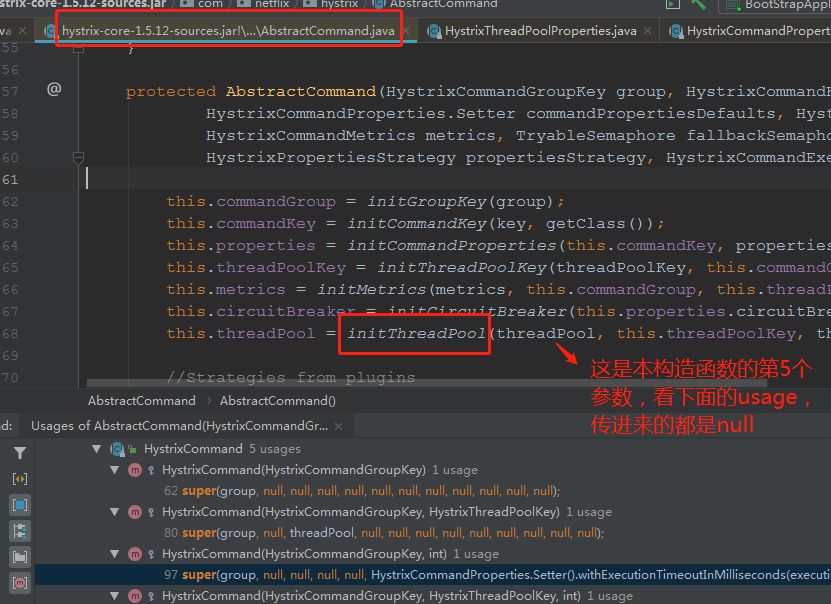使用Hystrix的插件机制,解决在使用线程隔离时,threadlocal的传递问题
背景
在我们的项目中,比较广泛地使用了ThreadLocal,比如,在filter层,根据token,取到用户信息后,就会放到一个ThreadLocal变量中;在后续的业务处理中,就会直接从当前线程,来获取该ThreadLocal变量,然后获取到其中的用户信息,非常的方便。
但是,hystrix 这个组件一旦引入的话,如果使用线程隔离的方式,我们的业务逻辑就被分成了两部分,如下:
public class SimpleHystrixCommand extends HystrixCommand<String> {
private TestService testService;
public SimpleHystrixCommand(TestService testService) {
super(setter());
this.testService = testService;
}
@Override
protected String run() throws Exception {
....
}
...
}
首先,我们定义了一个Command,这个Command,最终就会丢给hystrix的线程池中去运行。那,我们的controller层,会怎么写呢?
@RequestMapping("/")
public String hystrixOrder () {
SessionUtils.getSessionVOFromRedisAndPut2ThreadLocal();
// 1
SimpleHystrixCommand simpleHystrixCommand = new SimpleHystrixCommand(testService);
// 2
String res = simpleHystrixCommand.execute();
return res;
}
- 上面的1处,new了一个HystrixCommand,这一步,还是在当前线程执行的;
- 2处,在执行execute的过程中,最终就会把这个command,丢到线程池中,然后,command中的业务逻辑,就在线程池的线程中执行了。
所以,这中间,是有线程切换的,执行1时,当前线程里的ThreadLocal数据,在执行业务方法的时候,线程变了,也就取不到ThreadLocal数据了。
思路及实现
源码
如果没时间,可以直接看源码:
https://gitee.com/ckl111/all-simple-demo-in-work-1/tree/master/hystrix-thread-local-demo
从setter入手
一开始,我的思路是,看看能不能把hystrix的默认线程池给换掉,因为构建HystrixCommand时,支持使用Setter的方式去配置。
如下:
com.netflix.hystrix.HystrixCommand.Setter
final public static class Setter {
// 1
protected final HystrixCommandGroupKey groupKey;
// 2
protected HystrixCommandKey commandKey;
// 3
protected HystrixThreadPoolKey threadPoolKey;
// 4
protected HystrixCommandProperties.Setter commandPropertiesDefaults;
// 5
protected HystrixThreadPoolProperties.Setter threadPoolPropertiesDefaults;
}
-
1处,设置命令组
-
2处,设置命令的key
-
3处,设置线程池的key;hystrix会根据这个key,在一个map中,来查找对应的线程池,如果找不到,则创建一个,并放到map中。
com.netflix.hystrix.HystrixThreadPool.Factory final static ConcurrentHashMap<String, HystrixThreadPool> threadPools = new ConcurrentHashMap<String, HystrixThreadPool>(); -
4处,命令的相关属性,包括是否降级,是否熔断,是否允许请求合并,命令执行的最大超时时长,以及metric等实时统计信息
-
5处,线程池的相关属性,比如核心线程数,最大线程数,队列长度等
怎么样,可以设置的属性很多,是吧,但是,并没有让我们控制线程池的创建相关的,也没办法替换其默认线程池。
ok,那不用setter的方式,行不行呢?
从构造器入手
HystrixCommand 的构造函数,看看能不能传入自定义的线程池呢?

经过我一开始不仔细的观察,发现有一个构造函数可以传入HystrixThreadPool,ok,就是它了。但是,后面仔细一看,竟然是 package权限,我的子类,和HystrixCommand当然不是一个package下的,所以,访问不了这个构造器。
虽然,可以使用反射,但是,咱们还是守规矩点好了,再看看有没有其他入口。
寻找扩展口
仔细观察下,看看线程池什么时候创建的?
入口在下图,每次new一个HystrixCommand,最终都会调用父类的构造函数:

上图所示处,initThreadPool里面,会去创建线程池,需要注意的是,这里的第一个实参,threadPool,是构造函数的第5个形参,目前来看,传进来的都是null。为啥说这个,我们接着看:
private static HystrixThreadPool initThreadPool(HystrixThreadPool fromConstructor, HystrixThreadPoolKey threadPoolKey, HystrixThreadPoolProperties.Setter threadPoolPropertiesDefaults) {
if (fromConstructor == null) {
//1 get the default implementation of HystrixThreadPool
return HystrixThreadPool.Factory.getInstance(threadPoolKey, threadPoolPropertiesDefaults);
} else {
return fromConstructor;
}
}
上面我们说了,第一个实参,总是null,所以,会走这里的1处。
com.netflix.hystrix.HystrixThreadPool.Factory#getInstance
static HystrixThreadPool getInstance(HystrixThreadPoolKey threadPoolKey, HystrixThreadPoolProperties.Setter propertiesBuilder) {
String key = threadPoolKey.name();
//1 this should find it for all but the first time
HystrixThreadPool previouslyCached = threadPools.get(key);
if (previouslyCached != null) {
return previouslyCached;
}
//2 if we get here this is the first time so we need to initialize
synchronized (HystrixThreadPool.class) {
if (!threadPools.containsKey(key)) {
// 3
threadPools.put(key, new HystrixThreadPoolDefault(threadPoolKey, propertiesBuilder));
}
}
return threadPools.get(key);
}
- 1处,会查找缓存,就是前面说的,去map中,根据线程池的key,查找对应的线程池
- 2处,没找到,则进行创建
- 3处,new HystrixThreadPoolDefault,创建线程池
我们接着看3处:
public HystrixThreadPoolDefault(HystrixThreadPoolKey threadPoolKey, HystrixThreadPoolProperties.Setter propertiesDefaults) {
// 1
this.properties = HystrixPropertiesFactory.getThreadPoolProperties(threadPoolKey, propertiesDefaults);
// 2
HystrixConcurrencyStrategy concurrencyStrategy = HystrixPlugins.getInstance().getConcurrencyStrategy();
// 3
this.metrics = HystrixThreadPoolMetrics.getInstance(threadPoolKey,
concurrencyStrategy.getThreadPool(threadPoolKey, properties),
properties);
// 4
this.threadPool = this.metrics.getThreadPool();
...
}
-
1处,获取线程池的默认配置,这个就和我们前面说的那个Setter里的类似
-
2处,从HystrixPlugins.getInstance()获取一个HystrixConcurrencyStrategy类型的对象,保存到局部变量 concurrencyStrategy
-
3处,初始化metrics,这里的第二个参数,是concurrencyStrategy.getThreadPool来获取的,这个操作,实际上就会去创建线程池。
com.netflix.hystrix.strategy.concurrency.HystrixConcurrencyStrategy#getThreadPool public ThreadPoolExecutor getThreadPool(final HystrixThreadPoolKey threadPoolKey, HystrixThreadPoolProperties threadPoolProperties) { final ThreadFactory threadFactory = getThreadFactory(threadPoolKey); ... final int keepAliveTime = threadPoolProperties.keepAliveTimeMinutes().get(); final int maxQueueSize = threadPoolProperties.maxQueueSize().get(); ... // 1 return new ThreadPoolExecutor(dynamicCoreSize, dynamicCoreSize, keepAliveTime, TimeUnit.MINUTES, workQueue, threadFactory); } }上面的1处,会去创建线程池。但是,这里直接就是要了 jdk 的默认线程池类来创建,这还怎么搞?类型都定死了。没法扩展了。。。
发现hystrix的插件机制
但是,回过头来,又仔细看了看,这个getThreadPool 是 HystrixConcurrencyStrategy类的一个方法,这个方法也是个实例方法。
方法不能改,那,实例能换吗?再看看前面的代码:

ok,那接着分析:
public HystrixConcurrencyStrategy getConcurrencyStrategy() {
if (concurrencyStrategy.get() == null) {
//1 check for an implementation from Archaius first
Object impl = getPluginImplementation(HystrixConcurrencyStrategy.class);
concurrencyStrategy.compareAndSet(null, (HystrixConcurrencyStrategy) impl);
}
return concurrencyStrategy.get();
}
1处,根据这个类,获取实现,感觉有点戏。
private <T> T getPluginImplementation(Class<T> pluginClass) {
// 1
T p = getPluginImplementationViaProperties(pluginClass, dynamicProperties);
if (p != null) return p;
// 2
return findService(pluginClass, classLoader);
}
-
1处,从一个动态属性中获取,后来经查,发现是如果集成了Netflix Archaius就可以动态获取属性,类似于一个配置中心
-
2处,如果前面没找到,就是要 JDK 的SPI机制。
private static <T> T findService( Class<T> spi, ClassLoader classLoader) throws ServiceConfigurationError { ServiceLoader<T> sl = ServiceLoader.load(spi, classLoader); for (T s : sl) { if (s != null) return s; } return null; }那就好说了。SPI ,我们自定义一个实现,就可以替换掉默认的了,hystrix做的还是不错,扩展性可以。
现在知道可以自定义HystrixConcurrencyStrategy了,那要怎么自定义呢?
这个类,是个抽象类,大体有如下几个方法:
getThreadPool
getBlockingQueue(int maxQueueSize)
Callable<T> wrapCallable(Callable<T> callable)
getRequestVariable(final HystrixRequestVariableLifecycle<T> rv)
说是抽象类,但其实并没有需要我们实现的方法,所有方法都有默认实现,我们只需要重写需要覆盖的方法即可。
我这里,看重了第三个方法:
/**
* Provides an opportunity to wrap/decorate a {@code Callable<T>} before execution.
* <p>
* This can be used to inject additional behavior such as copying of thread state (such as {@link ThreadLocal}).
* <p>
* <b>Default Implementation</b>
* <p>
* Pass-thru that does no wrapping.
*
* @param callable
* {@code Callable<T>} to be executed via a {@link ThreadPoolExecutor}
* @return {@code Callable<T>} either as a pass-thru or wrapping the one given
*/
public <T> Callable<T> wrapCallable(Callable<T> callable) {
return callable;
}
方法注释如上,我简单说下,在执行前,提供一个机会,让你去wrap这个callable,即最终要丢到线程池执行的那个callable。
我们可以wrap一下原有的callable,在执行前,把当前线程的threadlocal变量存下来,即为A,然后设置到callable里面去;在callable执行的时候,就可以使用我们的A中的threadlocal来替换掉worker线程中的。
多说无益,这里直接看代码:
// 0
public class MyHystrixConcurrencyStrategy extends HystrixConcurrencyStrategy {
@Override
public <T> Callable<T> wrapCallable(Callable<T> callable) {
/**
* 1 获取当前线程的threadlocalmap
*/
Object currentThreadlocalMap = getCurrentThreadlocalMap();
Callable<T> finalCallable = new Callable<T>() {
// 2
private Object callerThreadlocalMap = currentThreadlocalMap;
// 3
private Callable<T> targetCallable = callable;
@Override
public T call() throws Exception {
/**
* 4 将工作线程的原有线程变量保存起来
*/
Object oldThreadlocalMapOfWorkThread = getCurrentThreadlocalMap();
/**
*5 将本线程的线程变量,设置为caller的线程变量
*/
setCurrentThreadlocalMap(callerThreadlocalMap);
try {
// 6
return targetCallable.call();
}finally {
// 7
setCurrentThreadlocalMap(oldThreadlocalMapOfWorkThread);
log.info("restore work thread's threadlocal");
}
}
};
return finalCallable;
}
- 0处,自定义了一个类,继承HystrixConcurrencyStrategy,准备覆盖其默认的wrap方法
- 1处,获取外部线程的threadlocal
- 2处,3处,这里已经是处于匿名内部类了,定义了2个field,分别存放1中的外部线程的threadlocal,以及要wrap的callable
- 4处,此时已经处于run方法的执行逻辑了:保存worker线程的自身的线程局部变量
- 5处,使用外部线程的threadlocal覆盖自身的
- 6处,调用真正的业务逻辑
- 7处,恢复为线程自身的threadlocal
获取线程的threadlocal的代码:
private Object getCurrentThreadlocalMap() {
Thread thread = Thread.currentThread();
try {
Field field = Thread.class.getDeclaredField("threadLocals");
field.setAccessible(true);
Object o = field.get(thread);
return o;
} catch (NoSuchFieldException | IllegalAccessException e) {
log.error("{}",e);
}
return null;
}
设置线程的threadlocal的代码:
private void setCurrentThreadlocalMap(Object newThreadLocalMap) {
Thread thread = Thread.currentThread();
try {
Field field = Thread.class.getDeclaredField("threadLocals");
field.setAccessible(true);
field.set(thread,newThreadLocalMap);
} catch (NoSuchFieldException | IllegalAccessException e) {
log.error("{}",e);
}
}
插件机制的相关资料
https://github.com/Netflix/Hystrix/wiki/Plugins
运行效果
controller代码
@RequestMapping("/")
public String hystrixOrder () {
// 1
SessionUtils.getSessionVOFromRedisAndPut2ThreadLocal();
// 2
SimpleHystrixCommand simpleHystrixCommand = new SimpleHystrixCommand(testService);
String res = simpleHystrixCommand.execute();
return res;
}
-
1处,设置ThreadLocal变量
public static UserVO getSessionVOFromRedisAndPut2ThreadLocal() { UserVO userVO = new UserVO(); userVO.setUserName("test user"); RequestContextHolder.set(userVO); log.info("set thread local:{} to context",userVO); return userVO; } -
2处,new了一个HystrixCommand,然后execute执行
command中代码
public class SimpleHystrixCommand extends HystrixCommand<String> {
private TestService testService;
public SimpleHystrixCommand(TestService testService) {
super(setter());
this.testService = testService;
}
@Override
protected String run() throws Exception {
// 1
String s = testService.getResult();
log.info("get thread local:{}",s);
/**
* 如果睡眠时间,超过2s,会降级
* {@link #getFallback()}
*/
int millis = new Random().nextInt(3000);
log.info("will sleep {} millis",millis);
Thread.sleep(millis);
return s;
}
重点看1处代码:
public String getResult() {
UserVO userVO = RequestContextHolder.get();
log.info("I am hystrix pool thread,try to get threadlocal:{}",userVO);
return userVO.toString();
}
如上所示,会去获取ThreadLocal变量,并打印。
spi配置
在resources\META-INF\services目录下,创建文件:
com.netflix.hystrix.strategy.concurrency.HystrixConcurrencyStrategy
内容为下面一行:
com.learn.hystrix.utils.MyHystrixConcurrencyStrategy
执行效果
2020-05-09 17:26:11.134 INFO 7452 --- [nio-8080-exec-2] com.learn.hystrix.utils.SessionUtils : set thread local:UserVO(userName=test user) to context
2020-05-09 17:26:11.143 INFO 7452 --- [x-member-pool-2] com.learn.hystrix.service.TestService : I am hystrix pool thread,try to get threadlocal:UserVO(userName=test user)
2020-05-09 17:26:11.143 INFO 7452 --- [x-member-pool-2] c.l.h.command.SimpleHystrixCommand : get thread local:UserVO(userName=test user)
2020-05-09 17:26:11.144 INFO 7452 --- [x-member-pool-2] c.l.h.command.SimpleHystrixCommand : will sleep 126 millis
2020-05-09 17:26:11.281 INFO 7452 --- [x-member-pool-2] c.l.h.u.MyHystrixConcurrencyStrategy : restore work thread's threadlocal
可以看到,已经发生了线程切换,在worker线程也取到了。
大家如果发现日志中出现了[ HystrixTimer-1] 线程的身影,不用担心,那只是因为我们的线程超时了,所以timer线程检测到了之后,去执行一个callable任务,那个runnable就是前面被我们包装过的那个callable。(这块超时的机制,todo吧,下次再讲)
总结
hystrix的插件机制,不止可以扩展上面这一个类,还有几个别的类也是可以的。大家直接参考:
https://github.com/Netflix/Hystrix/wiki/Plugins
代码demo,我放在了:
https://gitee.com/ckl111/all-simple-demo-in-work-1/tree/master/hystrix-thread-local-demo



 浙公网安备 33010602011771号
浙公网安备 33010602011771号